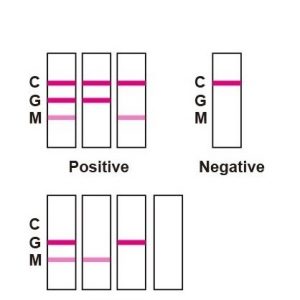-

- Home
- Shop
- Article
- About Us
- Contact Us
- Molecular Biology
- How to choose the right antibody
- Aflatoxin
- Vitamin K2
- Melatonin
- Introduction of ELISA Kits
- Food Safety Detection
- Food Safety
- Animal Disease
- Diagnosis
- Human ELISA
- Mouse ELISA
- Sheep ELISA
- Other ELISA
- Primary Antibody
- Second Antibodies
- Labeled Primary Antibody
- Labeled Secondary Antibody
- Small Molecular Antibody and Antigen
- Animal Disease Antibody and Antigen
- ELISA Test
- Rapid Test
- Diagnosis Antigen and Antibody
- Diagnosis Kit
Description
Principle:This reagent uses immunochromatography to rapidly and qualitatively detect dengue virus NS1 antigen and/or IgG, IgM antibodies in human whole blood, serum or plasma by double antibody sandwich method and capture method. The nitrocellulose membrane detection zone (T) of the dengue virus NS1 antigen test strip is coated with a monoclonal antibody against dengue virus NS1 protein, and the control region (C) is coated with an anti-mouse IgG polyclonal antibody. When the dengue virus NS1 antigen is contained and the concentration is higher than the minimum detection limit, the anti-dengue virus NS1 egg monoclonal antibody labeled with colloidal gold is combined with the dengue virus NS1 antigen in whole blood, serum or plasma to form a reaction complex. Under the action of chromatography, the reaction complex moves forward along the nitrocellulose membrane, and combines with the anti-dengue 毐NS1 protein monoclonal antibody pre-coated on the nitrocellulose membrane detection zone (T) to form a complex, and finally Forming a red reaction line visible to the naked eye, the result is positive; on the contrary, when the sample does not contain the dengue virus NS1 antigen or the concentration is lower than the minimum detection limit, no red reaction line appears in the detection area (T). The result is negative at this time. A red reaction line is formed in the QC zone (C) regardless of whether the sample contains NS1 antigen. The nitrocellulose membrane detection zone (T1, T2) of the dengue virus IgG and IgM antibody test strips are coated with anti-human IgG antibody and anti-human IgM antibody, respectively, and the quality control zone (C) is coated with biotin. When the sample contains dengue virus IgG antibody and the concentration is higher than the minimum detection limit, the dengue virus recombinant antigen labeled with colloidal gold is combined with the dengue virus antibody IgG in whole blood, serum or plasma to form a reaction complex. The reaction complex moves forward along the nitrocellulose membrane and is captured by the anti-human IgG antibody pre-coated with the detection zone (T1) on the nitrocellulose membrane, and finally forms a red-visible red reaction in the detection zone (T1). Line, the result is positive for dengue virus IgG antibody; similarly, when the sample contains dengue virus IgM antibody and the concentration is higher than the lower detection limit, a red reaction line visible to the naked eye will be formed in the detection area (T2). When the dengue virus lgG, IgM antibody is not contained in the sample or the concentration is lower than the minimum detection limit, no red reaction line appears in the detection area (T1, T2). For dengue Poison IgG, IgM antibody negative. Regardless of whether the sample contains IgG or IgM antibodies, a red reaction line is formed in the quality control zone (C).
Store:4-30℃,24 months.
Product performance index:
1.Detection sensitivity of NS1 test strip for dengue virus
Virus strain Minimum detection limit (analytical sensitivity)
Dengue virus type 1 8.3x100 TCID5O/ ml
Dengue virus type 2 8.3xl000TCID50/ml
Dengue virus type 3 1.5xl000TCID50/ml
Dengue virus type 4 3.0xl000TCID50/ml
2.The minimum detection limit for IgG on IgG and IgM test cards is 1:40, and the minimum detection limit for IgM is 1:20.
3. This reagent is not associated with measles, rubella, influenza A, typhoid fever, leptospirosis, hemorrhagic fever with renal syndrome, sepsis, epidemic cerebrospinal meningitis, hepatitis B virus, hepatitis C virus, AIDS, mites Positive samples of the disease cross-reacted. The dengue virus IgG and IgM antibody test strips of this reagent may cross-react with the positive samples of JE.
4.1142 clinical samples were selected [477 cases of positive samples by EL1SA method or PCR method, 665 cases of negative samples], and the evaluation reagents were used for detection. The positive coincidence rate was 89.73% (428/477), and the negative coincidence rate was 99.55% (662/665), the total compliance rate is 95.45% (1090/1142).
Specification:25T




